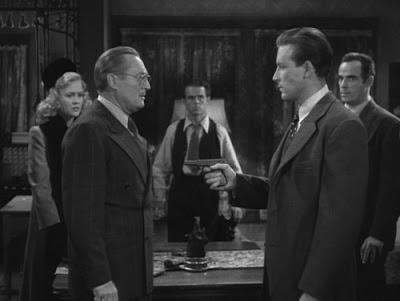Format: DVD from NetFlix on laptop.

There’s something fascinating to me about early crime films. In truth, 1945’s Dillinger doesn’t really qualify as being that early, since it’s right in the heart of the noir era. It’s an interesting Oscar nomination, since it was produced by Monogram, considered one of the better poverty row movie studios, which is sort of like the best looking person at a school for the blind. Like many movies of the era, it’s almost ridiculously short, clocking in at a spare 70 minutes. To its great benefit, though, it packs those 70 minutes with as much as it can, which very much includes a lot that doesn’t really seem to have much to do with the real John Dillinger.
In that respect, Dillinger is more of a spiritual biography of John Dillinger than one based in fact. It would seem that only his name is accurate in terms of the people in his life. Some of the broad sweeps—early imprisonment and learning the craft of crime from other criminals while in prison—seem to be accurate as well, but it would seem that none of the details are the real thing.
We start with newsreel footage and the appearance of Dillinger’s father (Victor Kilian), who tells the movie audience (both onscreen and watching this movie) that John (Lawrence Tierney) seemed like such a normal boy, but he didn’t seem satisfied with life on the family farm. From there, we flash forward to Dillinger heading to Indianapolis. While out on a date, a bartender embarrasses him by not taking his check. Needing money quickly, he robs a grocery store and is immediately captured and sent to prison.
In prison, Dillinger has the fortune to be put in a cell with Specs Green (Edmund Lowe), who is tough and mean, but is also an experienced and intelligent bank robber. Soon enough, John is learning his trade under Specs and the rest of his gang: Marco (Eduardo Ciannelli), Doc (Marc Lawrence), and Kirk Otto (Elisha Cook Jr.). Since Dillinger is in for a much shorter stay, he promises to break them out once he’s sprung.
Free again, he starts his life of crime immediately, holding up a movie theater ticket office being run by Helen Rogers (Anne Jeffreys). Helen points the finger at him, but fails to identify him in one of the funniest police lineups in film history; the other guys look nothing like Dillinger. Soon enough, Helen is John’s moll and John is plotting to get Specs and the gang out of the joint. He does so by smuggling guns to them, and soon all five are out and planning new heists. Things in the gang change when John comes up with the plan to knock off a difficult bank. Since it was his plan, he challenges Specs’s control of the gang. In retaliation, Specs sets him up and gets him arrested.
But hey, we know Dillinger is going to get out and we know he’s going to get his revenge. We also know that eventually he’s going to be gunned down outside of a Chicago movie theater, so that’s where we’re headed. The movie takes a great deal of license with getting us to that point, of course, but it’s all in service of a story filled with violent action and crime.
Lawrence Tierney’s job is two-fold in Dillinger. First, he’s supposed to be devilishly handsome, and I guess he qualifies. Second, he needs to be brutal and violent, which he does, kind of. One of the major problems with Dillinger is that it never shows us any of the violence that happens. I realize this was 1945, but the movie shies away even from showing someone getting shot. In one scene, just after his release from prison, Dillinger walks into the bar that wouldn’t take his check. He more or less confronts the server who kicked him out and got him started on his life of crime. Dillinger shatters a beer mug and, we assume, smashes the guy in the face with it. We don’t see this. We see the shattered mug and then see a part of the guy sliding off the seat. I don’t expect to see blood and guts here, but for a movie about one of the most famous criminals in America’s wild 1920s, it’s surprisingly prim.
I also don’t really understand the presence of the Helen Rogers character except for the fact that every movie seemed to require some sort of romance element. They are clearly an unhappy couple. In fact at one point Helen wants to run away from the gang, and chooses the new guy, Tony (Ralph Lewis) as her way out. Once again, we don’t see the violence here, but it is presumed that Dillinger bumps off Tony with an axe.
The truth is that Dillinger wants to be a thrill ride of violent crime from America’s past, but it never really shows us anything. All of the violence is implied. That would be okay if the film was even remotely accurate to Dillinger’s actual life, but it isn’t that, either. So I’m left with wondering what the point of it is. It’s not accurate and it doesn’t offer the sort of thrills that people going to see a movie called Dillinger would want.
Why to watch Dillinger: Once it starts, it doesn’t stop.
Why not to watch: For a film filled with violent material, it doesn’t show much.
